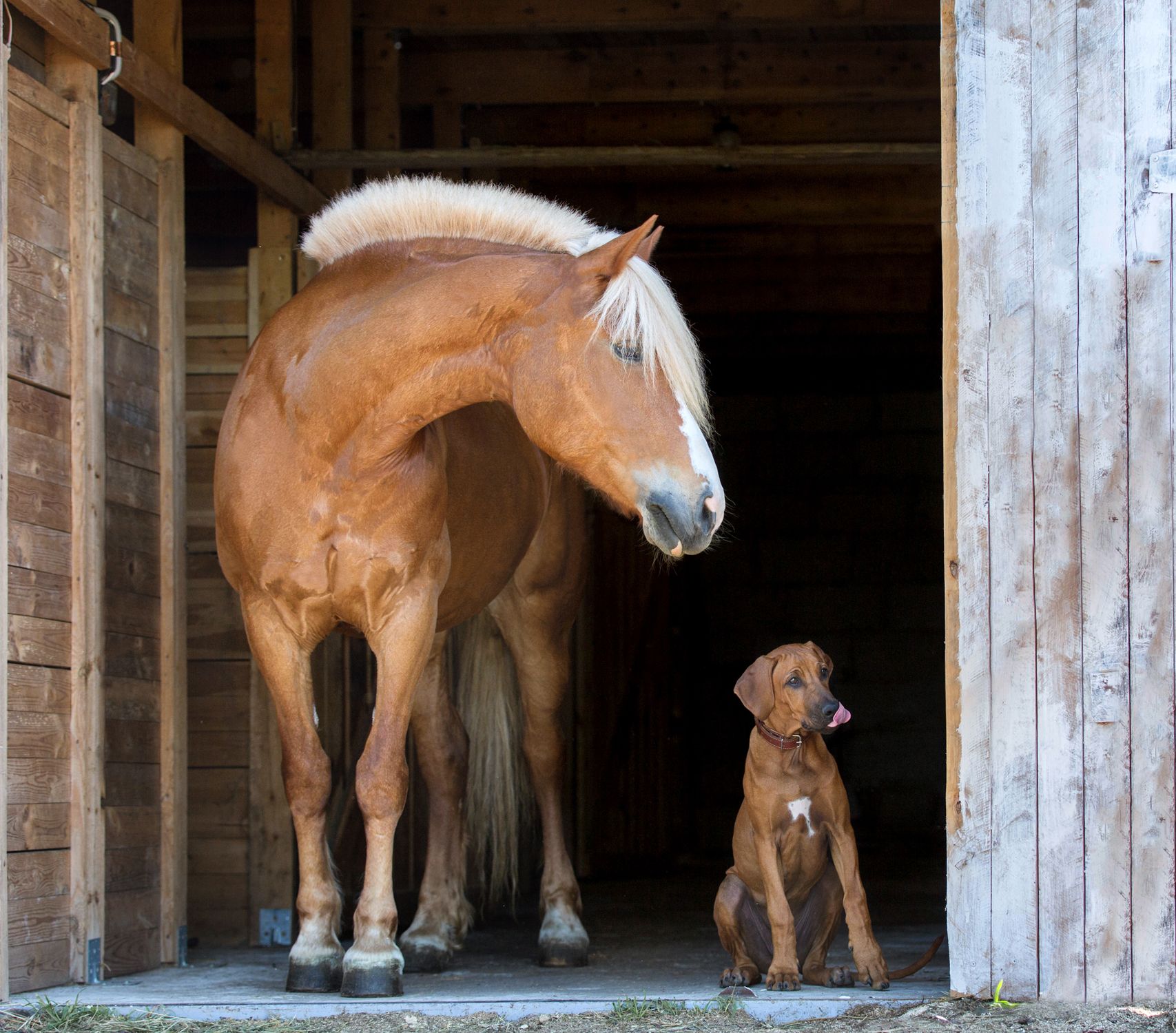Barn Dog Etiquette
Plus 5 steps to take, should your dog experience an on-farm injury


When you arrive to Horse and Hound Rescue Foundation, your welcome committee consists of dozens of dogs – big dogs, small dogs, and all of them sweet, old dogs. Some 50 senior dogs pulled from municipal Oklahoma shelters, and 50 off-track Thoroughbreds retiring from racetracks across the country, call this idyllic setting home.
“Basically, we are the dogs’ last resort because they are often considered unadoptable – simply because of their age and health problems, whether minor or major. We offer them a chance,” said Nelda Kettles of Horse and Hound Rescue Foundation. “If somebody comes along and falls in love, we adopt them out, but if not, they live out their life with us. They can roam the acreage and be a dog until the end.”
Nelda was eager to shed light on barn dog etiquette. For your horse’s and your dog’s well-being – and to not upset your barn buddies – keep her following tips in mind.
Training is No. 1. “If your dog doesn’t know how to respond to your cues and to look to you for leadership, then you can get into trouble. When your dog is at the barn with you, the main thing is for your dog to react to the commands to come back to you.”
Genetics run deep. “It is just common sense to know that if your dog is a herding breed or guard dog, make sure that you are at attention the first time your dog is introduced to a horse and help them to understand they are not to be chased or herded. They are companions, like you are. The Australian shepherds or any cow dog or herding breed is going to be right there. They are bred to herd; that’s what they think is their life’s work to do. Unless they are very trained, you do have to watch them a lot more. If you have those ground rules, and with proper training, it shouldn’t get out of hand.
Leashes are your friends. “I personally don’t think the dogs should be off leash at a show. There is simply too much stimulus, even for a well-trained dog.” Sidenote: Before taking your dog in tow with you to an equestrian event, check their regulations. Some grounds welcome dogs on a leash, while some do not welcome them at all, with the exception of service animals.
Watch out for the little guys. “The ones you also need to watch are the little guys who are afraid of nothing – like the chihuahuas who think they are rottweilers. While they have a tiny body, their heart is bigger than they are, and they think they are immortal.”
5 steps with an injury
Should your dog ever be injured while with you in the barn or while out working with horses, follow these five steps.
Monitor them right away. Should your barn dog experience an injury by a horse or equipment, monitor to determine if they are favoring any limbs; experiencing seizures; and are completely conscious. If they are unconscious, a veterinarian should see them immediately. Internal bleeding is always a risk with injury, and a veterinary examination is the safest check-step.
Share pictures with your veterinarian. Before driving to the clinic, use your cellphone to take pictures of the injury or wound, and share with your veterinarian. This will help the office prepare for your dog’s arrival and for swift treatment.
Have a 24-hour emergency veterinary clinic on speed dial. If your dog experiences head trauma, he requires precise care and likely, 24-hour monitoring, which is not always an option at a primary veterinary clinic. For such cases, it is best to immediately take your dog to the nearest emergency veterinary clinic or University veterinary school.
Refer to your stocked first-aid kit. Assist wounds to help stop any bleeding. If it’s a leg injury, wrap the leg just as you would wrap a horse’s leg (apply a sterile lube, then gauze and then cover with vet wrap or bandages, going in the direction of front to back with gentle support – not too tight or too loose).
In some cases, use direct pressure. If your dog experiences heavy bleeding, he could be suffering from a ruptured artery. Apply direct pressure to help stop excess blood loss. Get to your veterinarian, fast.
Keep these best practices in mind for memorable moments in the barn with your four-legged friends, big or small. From fun to pharmacy, visit veterinarian-founded ValleyVet.com for all of your pet and horse care needs.
About the author:
Valley Vet Supply content manager, Aimee Elyse Robinson, draws from her lifelong experience with horses, coupled with the veterinary wisdom bestowed upon her from her years working in animal health. She and her husband live on an Oklahoma ranchette that’s also home to off-track Thoroughbreds, Appaloosas, and rescue and foster dogs. A co-recipient of the 2022 AHP Equine Media NextGen Award.
Tags:Horse Sense

Acreage Life is part of the Catalyst Communications Network publication family.














